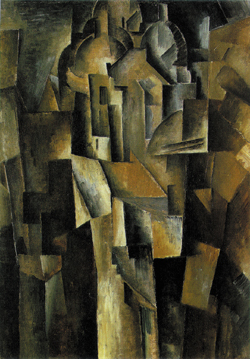Art History
At the end of the 19th Century, and the beginning of the 20th Century, the world was filled with conflict. With the changing of the whole society, the new knowledge and technology had increasing impacts on human life. Society was shifting from agriculture to machine culture. What people saw and heard changed radically, and the new art styles reflected these modern sensations. In Europe, there were many arts schools and exhibitions in the 1800's and early 1900's, and it was the place for artists to exchange and create ideas. Those artists were looking to balance the conflict between old fashions and new styles. New styles such as Cubism and Futurism were transferred to other countries and all these artistic styles were able to influence each other.
Cubism:
 Cubism introduced a new way to visualize the world, which is not using the eye but the mind to view the world. Apollinaire defined Cubism as the " art of painting original arrangements composed of elements taken from conceived rather than perceived reality" ("Juan Gris." 1). Cubism was developed by the Spaniard Pablo Picasso and the Frenchman Georges Braque in the early 1900's. They divided the subjects into numbers of facets and draw in different points- of- view. The "Analytical Cubism" which was started in 1912, usually uses subdued color and geometrical forms. In 1913 and 1914, "Synthetic Cubism" which had decorative shaped stenciling collage and 'bright colors,' was used. Picasso and Braque even brought 'cut-up newspaper' into their art works. "Cubism is no different from any other school of painting it is an art dealing primarily with forms" (McGuinness. Influences). After all, Cubism had become an important art style in the modern arts, and many art styles were truly influenced by Cubism.
Cubism introduced a new way to visualize the world, which is not using the eye but the mind to view the world. Apollinaire defined Cubism as the " art of painting original arrangements composed of elements taken from conceived rather than perceived reality" ("Juan Gris." 1). Cubism was developed by the Spaniard Pablo Picasso and the Frenchman Georges Braque in the early 1900's. They divided the subjects into numbers of facets and draw in different points- of- view. The "Analytical Cubism" which was started in 1912, usually uses subdued color and geometrical forms. In 1913 and 1914, "Synthetic Cubism" which had decorative shaped stenciling collage and 'bright colors,' was used. Picasso and Braque even brought 'cut-up newspaper' into their art works. "Cubism is no different from any other school of painting it is an art dealing primarily with forms" (McGuinness. Influences). After all, Cubism had become an important art style in the modern arts, and many art styles were truly influenced by Cubism.
Art Nouveau:
Art Nouveau, which was popular from the 1880s to the First World War and made a comeback in the 1960s, means 'New Art' in French. Art Nouveau was also one of the styles in the late Victorian Era. "If Art Nouveau was about finding beauty in organic intricacy, Art Deco was perhaps about finding beauty in geometric simplicity" (Phinney. 8). The major form of Art Nouveau is "characterized by this ornamental style of art, with its organic, asymmetrical, intricate and flowing lines" (8). In fact, Art Nouveau was a style opposite from Art Deco; however, they did share some similarities of style.
Art and crafts Movement:
Art and crafts Movement, one of the art movements of the in 1880s, originally happened in England and then spread throughout Europe in later years. It started with 'the Art Worker's Guild' at the London Exhibition organized in 1888. "William Morris is generally conceded to be its primary inspirational leader" (McGuinness. Influences). This movement was based on romantic idealism, and it introduced the vogue for 'nostalgia'. It also shared the style of functional design, using materials and techniques associated with Modernism. Art and Craft Movement influenced the stylistic of the European Art Nouveau and German Deutscher Werkbund movement. Today, it is becoming an important art movement in history to study.
Futurism:
In the years 1909 to the beginning of the First World War, Futurism took place in the Italian fine arts. The main leader, Filoppo Tommaso Marinetti, himself a poet, developed the notion of futurism. "The themes and forms are an attempt to attune the fine arts to an age of violence, machines and speed. 2. A similar tendency in literature and music" (Influences). With the other art movements of the same period, Futurism spread to other countries quickly, and became a popular style in the world.